Soil-Matters Spring 2011
TRIPLE L FARM (Carlisle, PA)
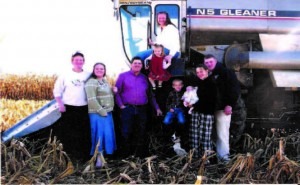
Experimenting with a number of crop varieties and fertilizer treatments, it wasn’t long before Lynn Hoover concluded that even the best genetics can’t help you overcome worn-out or poor soil.
Lynn is co-owner of Triple L Farm, a successful 120-cow dairy located in Carlisle, Pennsylvania.
Lynn joined his sister and brother in the family-owned and operated venture in 2003 after branching off from their Father’s failing operation. The threesome started out renting a nearby farm where, with the help of one spouse, they milked 50 cows two times per day.
In 2008 the siblings bought their great grandfather’s farm and moved up to a double herring bone parlor and 120 cows milked three times daily.
With the dairy industry facing economic constraints, to be successful Lynn knew he needed technology that could boost soil health and productivity and crop protection that worked more efficiently with less input. But it seemed like everything he tried forced a trade off either on cost, performance or environmental impact.
Then he tried Pro-Soil.
Used as part of a complete management program, a quality microbial fertilizer like Pro-Soil FOUNDATION, Lynn discovered, can increase silage tonnage, milk production and per acre profitability for dairy producers.
HIGH QUALITY HAY
The second cutting of Lynn’s first-year dry land alfalfa, for example, tested at 27% Crude Protein after two application of Pro-Soil.
“The treated vs. non treated Alfalfa also averaged 2% to 4% better each cutting,” says Lynn, who learned that one of the best ways to boost hay quality and yield is to feed the roots. He concentrates on producing a strong root system to support stronger stands and future growth.
To encourage deeper roots, Lynn delays the initial first cutting and takes it only when the soil surface is dry enough to minimize compaction. After every cutting Lynn applies Pro-Soil FOUNDATION at a rate of 16 ounces per acre. The result, Lynn says, is a healthier stand with less thinning, fewer weed problems and higher protein levels.
“The high protein haylage is helping to save on purchased protein which is good!” says Lynn. With such high protein levels, he expects this Alfalfa stand to make 90 lb milk without purchasing additional protein for the ration.
SUPERIOR SILAGE
Cornfields in Southern Pennsylvania experienced severe heat and drought challenges in 2010 that reduced pollination and ear development and resulted in lower tonnage and lower quality silage, which adversely affected dairy herds.
Such was not the case, however, for Lynn’s Pro-Soil treated corn fields. His fields stayed green and hung tough during the adversity, with a noticeable difference in Plant Health compared to untreated neighboring fields.
The root system delivered, stalks remained strong, and the plant made the most of a bad situation by continuing to fill big ears to the tip and put on dry matter, which at harvest amounted to 27 tons per acre — a 7 ton increase compared to the control and a 10.8 ton* advantage over farms in the area even with a 35,000+ population.
*F.I.R.S.T. 2010 Corn Silage Performance Summary for Pennsylvania South East
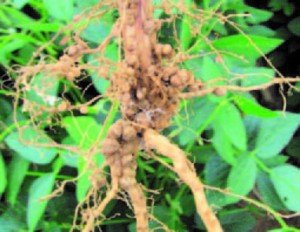
12 BUSHEL BETTER BEANS
Beginning in the Spring with fast emergence and early growth, Lynn’s Pro-Soil treated soybeans caught his eye. He watched them cruise through pollination and turn a dark green color that he says stayed green until harvest.
“I was surprised to see that after just one application, my Pro-Soil treated soybean plants appeared healthier throughout the season against my untreated soybeans,” Lynn says, “And I was blown away when I counted 90 pods per plant.” (He’d counted only 60 pods on plants from the control plot.)
Ultimately with Pro-Soil FOUNDATION™, Lynn says he gained an 8 to 12 bushel advantage over his untreated beans
TOP 10% – HIGH YIELD CORN
Like many growers planting on poor slate soils in Pennsylvania, Lynn has experienced slow emergence and poor seedling vigor. But he says one application of Pro-Soil FOUNDATION™ made a night a day difference in his corn harvest this year. With a personal best of 177 bushels per acre — 17 bushels more per acre than his best harvest to date — Lynn’s yields rank in the top 10% of high-yield corn in Pennsylvania, which he says, is more than he had hoped for. (The average corn yield in PA is 122 bu/acre.)
PRO-SOIL PERFORMANCE REPORT:
Our Top 10 of 2010
From coast to coast, Pro-Soil Biological Liquid Fertilizer Technology has shown impressive results. In independent research,on-farm field trials, first-year test plots and on farms that for years have been treated biologically with Pro-Soil FOUNDATION, STARTER PRO and TRIPLE 3 VITAL BOOST are seeing bigger roots, improved crop quality and consistently higher yields.What developments will determine trends in fertility during the next quarter century? Microbial products, like Pro-Soil that stimulate plant hormone, enzyme and root systems to help the crop overcome yield barriers caused by stress is the technology of the near future. Our technology can help keep your farm profitable against rising production costs and narrower contract margins and it’s environmentally responsible. Here are some of our top performers:
BUHL, IDAHO — BMZ Ag Solutions’ Ryon Murray notes a substantial increase in root size on a Croplan 3688 96 day corn variety treated with a 16 oz broadcast application of Pro-Soil FOUNDATION™ (right) compared to control (left.) The treated corn yielded 9.4 bushels per acre more.
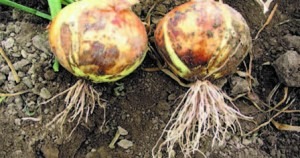
NYSSA, OREGON— These onions are from test plots that were planted on the same day and received identical fertility. In addition, the onion on the right received one application of Pro-Soil STARTER PRO™. The onion on the left did not.
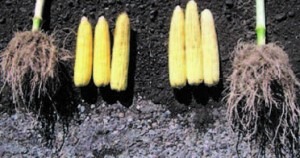
FILER, IDAHO— A Croplan 7428 100-Day Corn variety treated with 16 ounces per acre of Pro-Soil FOUNDATION™ (right) outperforms the control plot of the same variety in a field demo planted three weeks earlier (left.)
100 BUSHEL BEANS

SMALL FARMS – At 110 bushels per acre with test weights averaging 60 lbs. per bushel, this marks the 5th consecutive season for Ron Small to raise 100-bushel soybeans.
And we’re not talking contest plots. Ron has
proven that 100 bushel soybean yields are possible in real-world conditions on farm-size no-till commercial fields. Biologically managed for eight years, Ron plants early, plants narrow (15 inch) rows and treats 100% of his acres with 12.8 ounces per acre of Pro-Soil FOUNDATION™ which he broadcasts with his first Roundup pass.
Ron says Pro-Soil warms up cold soils and provides immediately available nutrients which enables him to plant as soon as his soils and the weather cooperate.
283 BUSHEL CORN
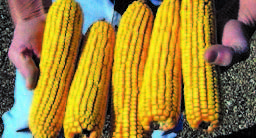
MACE’S PLEASANT VALLEY FARMS – Rod Mace reports producing his “BEST CORN EVER!” with one field yielding 283 bushels per acre and a farm average of 212 bushels. That’s *50 bushel per acre more than the average yield of farms in his area
Biologically managed five years, Rod applies
12.8 ounces per acre of Pro-Soil FOUNDATION™ directly in row with the seed; followed by an additional 12.8 oz/ac broadcast application in the Fall.
His third year on the program, Rod dropped applied N down from 180 lbs/acre to 147, which he applies at different times. Rod says split nitrogen applications are “key on this program — spoon-feeding is what I call it.”
*F.I.R.S.T. 2010 Better Hybrids Performance Summary for Indiana South.
THREE TIME’S THE CHARM
BINK LAND AND CATTLE – Our most significant results on wheat have come with anearly season “Prime & Activate” approach developed by researchers and growers like John Bink. This year, John’s wheat averaged 70 bu/acre and tested at 63 lbs./bu — double that of area farms.
Biologically managed for five years, he achieved this with just 30 units of 32-0-0. First John ‘primes’ the soil system by applying FOUNDATION™ as early as possible in the plant’s life. A second application, within six weeks of the first, builds on this to properly ‘activate’ the system (soil microbes.) Last but not least, he follows up with two 12.8 oz top dress applications of Triple 3 Vital Boost™ to add energy when the plants need it most.
Where’s the money in potatoes?
It’s in the roots, not in the tops. More roots mean less stress for the “root dominant” Potato plant, allowing it to produce a superior product. The more roots you have the more stolen-creating hormone will be produced. Without stolen you don’t get tubers which are started by the same hormone. More roots also condition the plant to keep growing during drought and extreme w e ather an d temperatures.
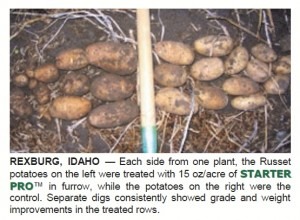
IDAHO (JK Farms) -In a full season of on-farm field research on Norkotah Potatoes conducted by BMZ AG Solutions, a single in-furrow application of Pro-Soil STARTERSTARTER PROPRO™ (16 oz/ac) not only increased root size, but also produced more potatoes at harvest and increased their size. The greatest increase (128%) was in Baker size potatoes. Addi tional increases compared to control included a: 19.4% increase in total sample weight, 53.6% increase in 6 ounce #2’s and an 88.6% decrease in Pink Rot. STARTERSTARTER PROPRO™ works by inducing the potato plant to produce more of its own gr owt h stimulating enzymes and hormones, helping it overcome seasonal stress-related setbacks and prom o t i ng the continued transport of photosynthesis products, minerals and water to the tuber, assuring higher yields and improved size distribution and quality. Uniquely suited to the potato crop, early application of STARTER PROSTARTER PRO™, prior to hooking (tuber set,) has great potential for the seed grower looking for maximum tuber set and uniformly sized tubers.

